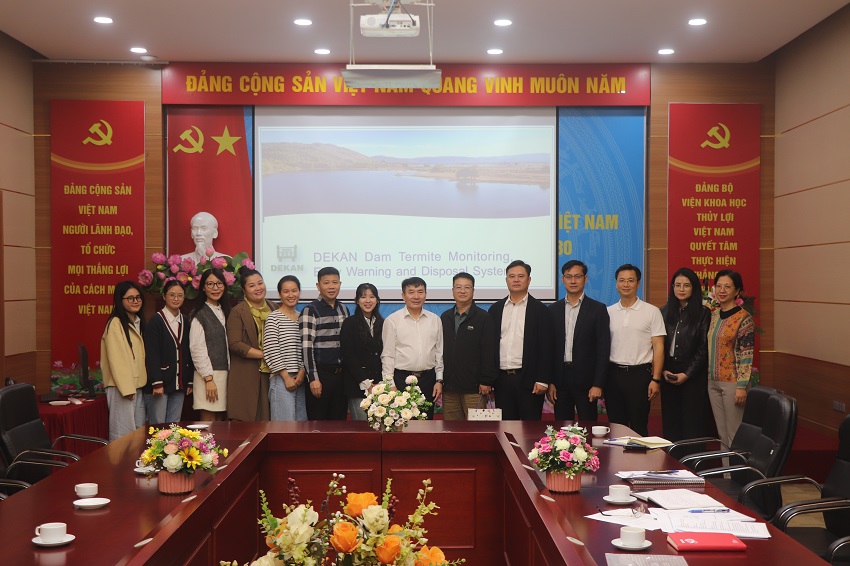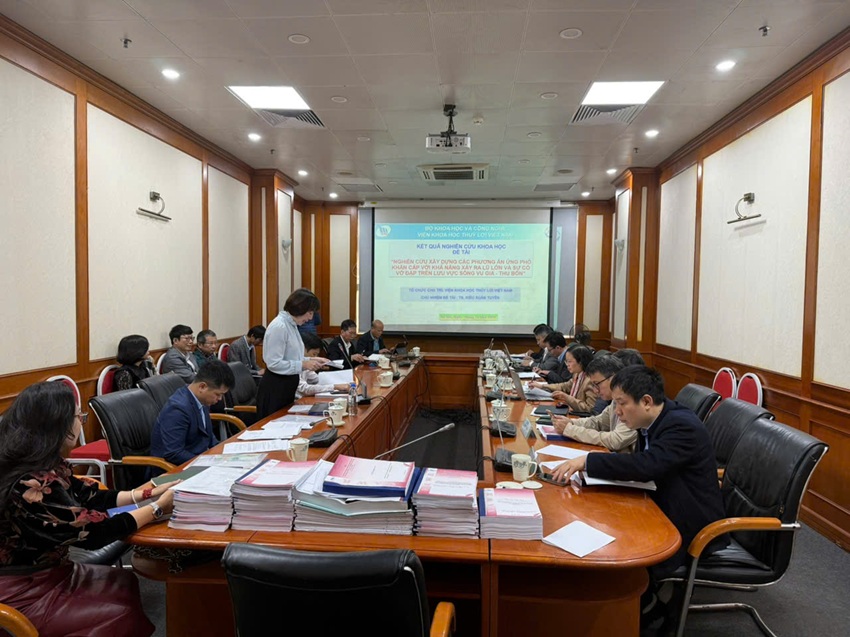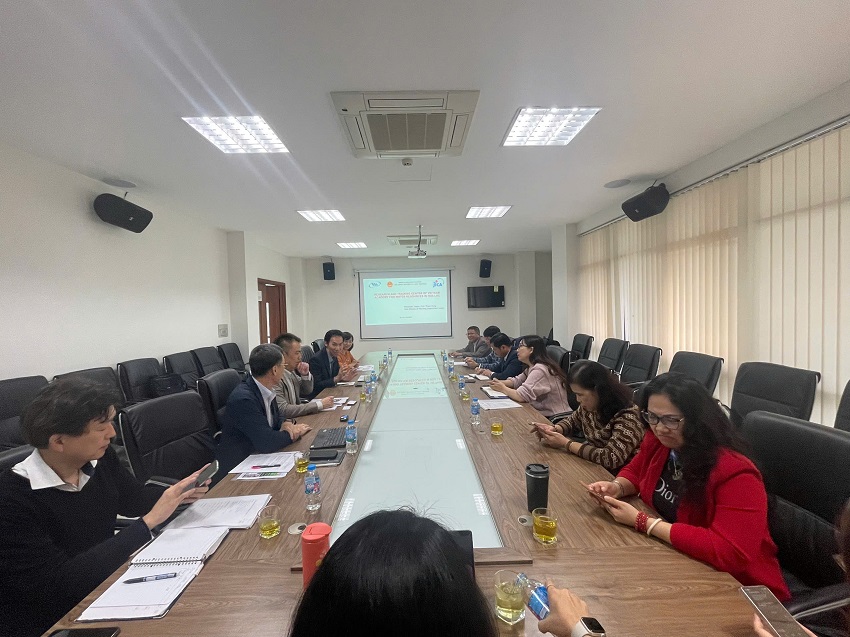Satellite-based monitoring of contrasting characteristics of suspended sediment discharged from the Red and the Ma river systems along the northern coast of Vietnam
26/08/2021The northern coast of Vietnam has accumulated asignificant amount of sediment discharged fromthe multiple distributaries of rivers such as the Red River and Ma River. While recent decreases of these diment supply appears to have a significant impact on coastal erosion, the complex network of these distributaries makes it difficult to determine the overall spatiotemporal characteristics of sediment discharges and related topographic changes. The goal of the current study is to develop a satellite-based monitoring system for observation of turbidity discharged from the multiple rivers and to investigate the applicability of the developed monitoring system through acase study on the northern coast of Vietnam. Based on the in-situobserved data, a formula was determined for estimation of the surface water turbidity as a function of the red band reflectance of Moderate Resolution Imaging Spectro-radiometer (MODIS) images. The formula was then combined with a newly determined threshold for cloud-masking to obtain maps of the nearshore turbidity patterns. These maps capture the spatiotemporal water surface turbidity along the entire coast of the Red River Delta and the coast around the Ma River mouth over the past sixteen years with frequency of twice a day. Finally, long-term trends of the turbidity patterns from multiple rivers were compared with thein-situobservation data and it was found that the Red River and the Ma River showed clearly contrasting characteristics,which reasonably explain the recent coastalshoreline changes and characteristics of sediment sampled along the coast.
1. Introduction
2. Development of satellite-based monitoring system of near- shore turbidity patterns
2.1. Field survey
2.2. Turbidity mapping
2.3. Cloud masking
3. Validities and characteristics of the developed monitoring system
3.1. Daily and monthly turbidity along the northern coast of Vietnam
3.2. Areas of high turbidity
3.3. Tidalinfluence onobservedturbiditypatterns
3.4. Relation between the monthly-average river water level and observed turbidity
3.5. Long-term trend of turbidity patterns around the Ma River and the Red River mouths
4. Discussion
5. Conclusions
References
Ackerman, S. A., Strabala, K. I., Menzel, W. P., Frey, R. A., Moeller, C. C., & Gumley, L. E. (1998). Discriminating clear sky from clouds with MODIS. Journal of Geophysical Research, 103(D24), 32141.
Ahmed, M. T. T., Sato, S., & Tajima, Y. (2014). Quantitative estimation of longshore sediment transport based on thermoluminescence: Two case studies around Tenryu and Nile river mouths. Journal of Coastal Research, 30(3), 537–547.
Do, D. M., Mai, N. T., Chu, N. V., Tran, N., Dao, T. M., Weering, T. C. E., & Bergh, G. D. (2007). Sediment distribution and transport at the nearshore zone of the Red River delta, Northern Vietnam. Journal of Asian Earth Sciences, 29, 558–565.
Dogliotti, A. I., Ruddick, K., & Guerrero, R. (2016). Seasonal and inter-annual turbidity variability in the Rio de la Plata from 15 years of MODIS: El Nino dilution effect. Estuarine, Coastal and Shelf Science, 182, 27–39.
Doxaran, D., Froidefond, J. M., & Castaing, P. (2002). A reflectance band ratio used to estimate suspended matter concentrations in sediment-dominated coastal waters. International Journal of Remote Sensing, 23, 5079–5085.
Doxaran, D., Froidefond, J. M., Castaing, P., & Babin, M. (2009). Dynamics of the turbidity maximum zone in a macrotidal estuary (the Gironde, France): Observations from field and MODIS satellite data. Estuarine, Coastal and Shelf Science, 81(3), 321–332.
Farooq, S. (2011). Spectral reflectance of land covers. Aligahr, India: Department of Geology, Aligahr Muslim University. 〈http://www.geol-amu.org/notes/m1r-1-8.htm〉.
Feng, L., Hu, C., Chen, X., & Song, Q. (2014). Influence of the Three Gorges Dam on total suspended matters in the Yangtze Estuary and its adjacent coastal waters: Observations from MODIS. Remote Sensing of Environment, 140, 779–788.
Gunasekara, K., Tajima, Y., Le, C. H., Ho, C. V., Nguyen, H. T., & Le, H. M. (2016). Satellite based monitoring of turbidity around Hai Phong Bay, Vietnam. Journal of JSCE B3 (Ocean Engineering), 72(2), I_772–I_777.
Hennig, T., Wang, W., Magee, D., & He, D. (2016). Yunnan's fast-paced hydropower development: A powershed-based approach to critically assessing generation and consumption paradigms. Water, 8(10), 476.
Hu, C. M., Chen, Z. Q., Clayton, T. D., Swarzenski, P., Brock, J. C., & Muller-Karger, F. E. (2004). Assessment of estuarine water-quality indicators using MODIS medium-resolution bands: Initial results from Tampa Bay, FL. Remote Sensing of Environment, 93(3), 423–441.
Keizars, K. Z., Forrest, M., & Rink, W. (2008). Natural residual thermoluminescence as a method of analysis of sand transport along the coast of the St. Joseph Peninsula, Florida. Journal of Coastal Research, 24(2), 500–507.
Le, Q. T. P., Garnier, J., Gilles, B., Sylvain, T., & Chau, M. V. (2007). The changing flow regime and sediment load of the Red River, Vietnam. Journal of Hydrology, 334 (2), 199–214.
Lewis, J., & Eads, R. (2001). Turbidity threshold sampling for suspended sediment load estimation. , In Proceedings of the Seventh Federal Interagency Sedimentation Conference, pp. 110–117, Las Vegas.
Lippmann, T. C., & Holeman, R. A. (1989). Quantification of sand bar morphology: a video technique based on wave dissipation. Journal of Geophysical Research, 94, 995–1011.
Liu, H., Tajima, Y., & Sato, S. (2010). Long-term monitoring on the sand spit morphodynamics at the Tenryu River mouth. Coastal Engineering Proceedings (p. 15), 15.
Liu, R., & Liu, Y. (2013). Generation of new cloud masks from MODIS land surface reflectance products. Remote Sensing of Environment, 133, 21–37.
Lu, X. X., Oeurng, C., Le, T. P. Q., & Thuy, D. T. (2015). Sediment budget as affected by construction of a sequence of dams in the lower Red River, Viet Nam. Geomorphology, 248(1), 125–133.
Morris, B. D., Davidson, M. A., & Huntley, D. A. (2001). Measurements of the response of a coastal inlet using video monitoring techniques. Marine Geology, 175, 251–272.
Nguyen, H. M., & Larson, M. (2014). Coastline and river mouth evolution in the central part of the Red Revier Delta In: N. D. Thao, H. Takagi, & M. Esteban (Eds.), Coastal disasters and climate change in Vietnam (pp. 43–79). Amsterdam: Elsevier.
Nguyen, H. T., Vu, C. D., & Nguyen, H. T. (2016). Prediction of the change of the Ma river bed level under impacts of upstream hydro-electric reservoir. Journal of Water Resources Science and Technology, 30, 98–110. (In Vietnamese)
Nguyen, N. T. K., Le, V. T. H., & Tran, T. T. T. (2011). Mapping of Red River Delta shoreline evolution from 2001 to 2010 by satellite technology and GIS. Hanoi, Vietnam: Institute of Mechanics. (In Vietnamese)
Nguyen, Q. C., & Pham, H. V. (2016). Characteristics of dynamic geomorphology of coastal-river mouth zones of Ma river of Thanh Hoa province. Vietnam Journal of Earth Sciences, 38(1), 59–66. (In Vietnamese)
Nguyen, Q. N. (2017). Estimation of change of coming sediment to the Red River and causes of sediment reduction in the period of 2000–2015. Journal of Water Resources Science and Technology, 41, 2–8. (In Vietnamese)
Nordkvist, K., Loisel, H., & Gaurier, L. D. (2009). Cloud masking of SeaWiFS images over coastal waters using spectral variability. Optics Express, 17(15), 12246–12258.
Park, E., & Latrubesse, E. M. (2014). Modeling suspended sediment distribution patterns of the Amazon River using MODIS data. Remote Sensing of Environment, 147, 232–242.
Petus, C., Chust, G., Gohin, F., Doxaran, D., Froidefond, J. M., & Sagaminaga, Y. (2010). Estimating turbidity and total suspended matter in the Adour River plume (South Bay of Biscay) using MODIS 250-m imagery. Continental Shelf Research, 30(5), 379–392.
Petus, C., Marieu, V., Novoa, S., Chust, G., Bruneau, N., & Froidefond, J. M. (2014). Monitoring spatio-temporal variability of the Adour River turbid plume (Bay of Biscay, France) with MODIS 250-m imagery. Continental Shelf Research, 74, 35–49.
Rasanen, T. A., Someth, P., Lauri, H., Koponen, J., Sarkkula, J., & Kummu, M. (2017). Observed river discharge changes due to hydropower operations in the Upper Mekong Basin. Journal of Hydrology, 545, 28–41.
Robinson, W. D., Franz, B. A., Patt, F. S., Bailey S. W., & Werdell, P. J. (2003). Masks and flags updates, In S. B. Hooker, E. R. Firestone, (Eds.), NASA Technical Memorandum, 22, (34–40).
Siegle, E., Huntley, D. A., & Davidson, M. A. (2007). Coupling video imaging and numerical modeling for the study of inlet morphodynamics. Marine Geology, 236, 143–163.
Tajima, Y., Liu, H., & Sato, S. (2009). Dynamic changes of waves and currents over the collapsing sandbar of the Tenryu river mouth observed during Typhoon T0704, Proceedings, Coastal Dynamics 2009-Impacts of Human Activity on Dynamic Coastal Processes.
Takagawa, T., Tajima, Y., Liu, H., Takewaka, S., & Sato, S. (2011). Dynamic topography changes of sand spit of the Tenryu River mouth due to overtopping waves In: P. Wang, J. D. Rosati, & T. M. Roberts (Eds.), The Proceedings of the Coastal Sediments 2011 (pp. 1217–1228). World Scientific.
Takewaka, S. (2016). Observation of whole flushing process of a river sand bar by a flood using X-bad radar. Journal of Marine Science and Engineering, 4(32).
Vermote, E.F. & Vermeulen, A. (1999). MODIS algorithm technical background document, atmospheric correction algorithm: Spectral reflectance (MOD09). NASA, contract NAS5-96062.
Vu, V. D., Ouillon, S., Tran, T. D., & La, C. V. (2014). Impact of the Hoa Binh dam (Vietnam) on water and sediment budgets in the Red River basin and delta. Hydrology and Earth System Sciences, 18, 3987–4005.
Wang, M., & Shi, W. (2005). Estimation of ocean contribution at the MODIS nearinfrared wavelengths along the east coast of the U.S.: Two case studies. Geophysical Research Letter, 32, L13606.
Wang, M., & Shi, W. (2006). Cloud masking for ocean color data processing in the coastal regions. IEEE Transactions on Geosciences and Remote Sensing, 44, 3196–3205.
Yoshimitsu Tajima a,n, Kavinda Gunasekara b, Hung Thanh Nguyen c
a Department of Civil Engineering, Graduate School of Engineering, The University of Tokyo, 7-3-1 Hongo, Bunkyo-ku, Tokyo 113-8656, Japan
b Geo-Informatics Center, Asian Institute of Technology, Pathumthani 12120, Thailand
c Key laboratory of River and Coastal Engineering, Vietnam Academy of Water Resources, Hanoi, Vietnam
International Journal of Sediment Research
Ý kiến góp ý:









